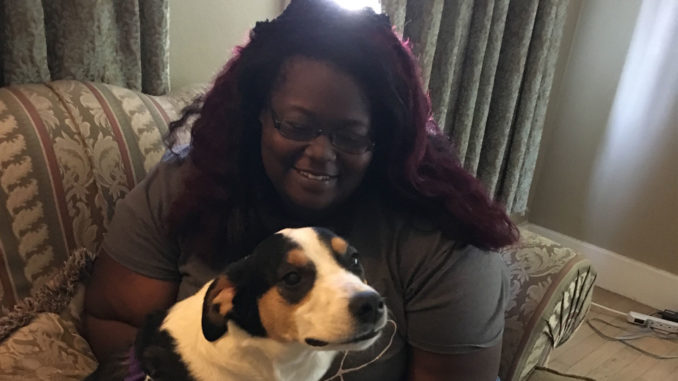
With close to 25 students living on Truman’s campus this semester with an emotional support animal, curiosities and misconceptions about ESA’s have spread across the Truman community. Some questions about ESA’s revolve around how people can get ESA’s, what purpose they serve, the ethics of having them in certain spaces, and the overall stigmas that surround ESA’s and mental health as a whole.
Director of Residence Life John Gardner said students are allowed to have ESA’s on campus because of a clause within the Fair Housing Act. Gardner said the Fair Housing Act allows students to bring animals if they have an emotional or mental health need. In addition, he said the Fair Housing Act cannot limit where an animal can reside or what kind of animal can be an ESA as long as it is an animal legally allowed within Kirksville city limits. For example, a student could have an emotional support snake but not an emotional support hippopotamus.
Gardner said the process of getting an ESA begins by submitting a request through the Disability Services Office. After showing proper documentation — including an accommodation letter from an external counseling center and paperwork indicating the animal has received proper vaccinations and medical procedures — the animal gets approved. After approval is granted, Gardner said the student meets with Residence Life to talk about the logistics of having an animal on campus, and those living on the same floor near the animal are notified via email.
Gardner said there have been instances where some people living on a floor with an ESA have expressed concern because of allergies or phobias, but generally they do not feel concerned once they are informed the ESA will stay in the individual student’s room and is not permitted to go to any other locations of the residence hall except to be taken outside for the bathroom. Gardner added that unlike service animals, ESA’s can only be in certain housing spaces and aren’t allowed in class, the SUB, the Rec Center or the library.
Gardner encourages students to consider if it would be best for both their own well being as well as the animal’s before getting an ESA.
“I really want folks — if they’re thinking about an emotional assistance animal — [to think] is it also good for the animal?” Gardner said. “If you think about an animal you would choose for that, think about, is there an appropriate animal to choose? Rather than, say, a big dog, would a guinea pig or bunny serve the same purpose for someone?”
Gardner also said there have been times when students have brought emotional support animals to campus and then changed their mind after taking the animal into consideration.
One student who formerly lived in Missouri Hall, junior Monique Miller got her ESA, a dog named Milo, in December 2016. She adopted him when he was a puppy from the Adair County Humane Society and said when she saw him it was instant love. Miller said Milo helps her with PTSD.
“He really just helps me stay out of a dark place,” Miller said. “My brain will start to wander into really bad memories … I can focus my attention on him rather than having really terrible thoughts. He just makes a really good listener if I’m feeling down.”
Miller said she has to deal with negative attitudes from others in Reslife, a previous roommate and her current landlord for not understanding or holding negative stigmas about her and Milo.
Miller said dealing with negative people on campus is ultimately why she now lives off-campus, where she believes both her and Milo are a lot happier.
“I don’t care if you don’t like me, but you’re not going to be rude to my dog,” Miller said. “He means a lot to me. He means more to me than I mean to my own self, if that makes sense … I take care of his safety and everything and that gives me purpose.”
Miller said Milo serves as an alternative option for her as opposed to taking medicine, and Milo is her little burst of joy.

Sophomore Courtney Atwell also has her own burst of joy, a dog named Jazza, as her ESA. Atwell currently lives in Blanton Nason Brewer Hall with Jazza and said she is a very intuitive and loving animal.
“… Her main thing is that she provides comfort through depression and anxiety attacks,” Atwell said. “It’s mostly just being able to have someone with me and someone that will cuddle me and will have physical contact with. That really helps. It’s kind of cool, because she can tell when I’m sad and she’ll bring all her toys to me when I’m sad, which is cool because animals have that thing where they just know.”
Atwell said one misconception she’s noticed about ESA’s is they have to be trained or a certain kind of animal. She said as long as an ESA is helping you, it should not matter what animal it is. She also said some believe all ESA’s should be dogs because service animals tend to be dogs, which is also not the case.
Junior Arin Jarman also said ESA’s can vary depending on the person, and it’s important for someone getting an ESA select the right animal for them.
Jarman, who has her cat Achilles as an ESA in West Campus Suites, said she often recommends people start with a fish as an ESA to make sure they feel they can handle how much an ESA alters your life schedule. Jarman also added that people who might not be able to take care of an ESA can benefit from emotional support plants.
Jarman — who has depression, anxiety and PTSD — said cats have always helped her through her emotional struggles and taking care of a cat motivates her to take care of herself.
Jarman said a lot of the stigmas about ESA’s come from those surrounding mental health as a whole.
“A lot of people just don’t recognize and or understand that mental health is a thing,” Jarman said. “So when somebody hears ‘oh, it’s an emotional support animal’ you get the stereotypical ‘Oh, you’re a baby. You can’t take care of yourself. You can’t be away from your pet for 30 minutes.’”
Jarman said while Achilles has helped her through many dark times, an ESA, or any treatment for mental health, is not supposed to serve as a cure-all but, rather, a stepping stone toward healing.
“Life’s not easy,” Jarman said. “Nothing’s going to be easy. And it’s not going to be easy because you have this animal. Instead of it being easier, it will just be somebody to work through it with you. Companions are important. And if you don’t have anybody human-wise you can connect with, animals are important.”
Senior Morgan Grandon also has a cat as an ESA living in West Campus Suites named Diane.
Grandon said while she worried she would feel a lot of judgment, the Truman student body for the most part was accepting of her having an ESA.
“I was a little worried about people looking at me and going ‘oh my god, you’re troubled,’” Grandon said. “But I think people at Truman are pretty accepting and acknowledging of mental health … everyone in my dorm is just so excited to have an animal living amongst us. We have neighbors who buy her cat treats. Everyone’s been super accommodating and good about it, and I think everyone understands that a lot of college kids have poor mental health and animals can be helpful.”

Because Grandon had to take a medical withdrawal in the Fall 2016 semester, she said Diane has been a friend to her at school when a lot of her close human friends have already left Truman.
“I would say the biggest benefit is just that constant companionship,” Grandon said. “Because I wasn’t here for a semester, a lot of my friends ended up graduating, so a lot of the people I was closest with aren’t on campus anymore so having an animal helps me out. Having a creature who’s always happy to see you, who’s always pumped that you’re coming back to the dorms makes your life a little easier.”
